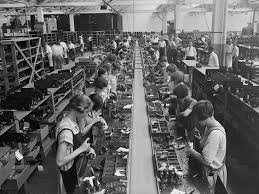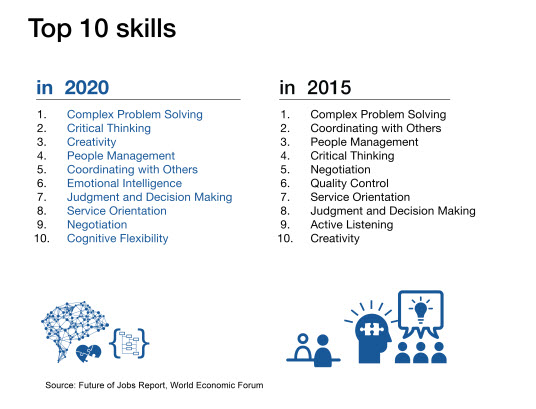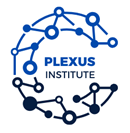This post was adapted from several articles by Arnold Beekes, who shared his work in a Pop-Up Conversation. You are invited to listen to the second half of the conversation.
Do you believe that you will be an employee from graduation until retirement? Do you know what it means to be employed? The changes in the conditions and patterns of employment are shifting so rapidly that it is virtually impossible to plan for your entire work life. The speed of automation and robotization indicates that many jobs (blue-collar and white-collar) will disappear. In fact, that is happening now with many jobs reaching their expiration date! Many experts contend that the lifespan of companies is also shifting, leaving employees and clients the need to learn how to continually adapt.
How we work and live is clearly in a system-wide ‘transition’, the process or a period of changing from one state or condition to another. We have been slowly moving out of the Industrial Age, which is characterized by efficiency, repetition and standardization, but are still relying on a ‘system of sameness’ that offers a false security in being able to predict outcomes.
Ultimately the jobs of the future will focus on serving four basic human needs – exploration, connection and creation as well as the learning required to do the first three more effectively. John Hagel
We are also operating in a new paradigm, which some people call the Information Age. I am not convinced that the name, Information Age, adequately reflects our ecosystems, I see information as, the enabler, rather than the purpose and intention. I like to call it the Connection Age (characterized by creation, contribution and participation – building a ‘universe of uniqueness’), to be truly connected with ourselves, with others, animals and with nature.
We are still moving between states with increasingly disruptive systemic symptoms emerging during the transition.
- High levels of stress and burn-out
- Feelings of uncertainty, anxiety and discontentment
- Economic consolidation of wealth
- Mega corporations, who control the output of almost all consumer purchases
- Deepening disruptions and crises in global systems (economic, financial, climate change, poverty)
- Increasing unemployment and skill deficits, especially for young people
- Growing distrust in governments and corporations
- Education doesn’t meet the market’s needs
- Discrimination (gender, age, race) is still alive
We cannot apply the old rules of the Industrial Age to the new game of the Connection Age. Instead of focusing what doesn’t work anymore, we need to build new ways of living and working, together. What does this look like? Here are some perspectives on the old and new paradigms of working.
WORKING, The Basics
The industrial age brought compliance and compliance brought fear and fear brought us mediocrity. – Seth Godin

In this employment scenario, many employees are segmented into pre-ordained roles and expectations. Careers, in a profession or industry are the norm, often with little variation from start until retirement. Work is mostly done in one physical location. The individual’s ability to ‘fit in’ is an indication of the opportunities and advancement in their career.

The partners are experts, generalists and/or intrapreneurs, across many domains. Most work is project-based, virtual and thus has no geographical limitation. Your capacitys to ‘flying out’ is a sign of your fulfillment and prosperity in life and work.
Fit in or Fly out
This shift from the Industrial Age into the Connection Age requires a complete new way of leadership and management, and most significantly, how people work. The command and control management style served a necessary function in the Industrial Age, but is totally inappropriate for the Connection Age. Why? If you want people to take initiative and be creative, then you need to create the conditions for continuous engagements and collaborations, you should not tell them upfront what to do. When you limit the ability for people to bring their diverse experience and skills , you limit their creative thinking and hence their output.
 Fitting people into a standardized corporate mold doesn’t benefit individuals or organizations. Fitting in focuses on managing weaknesses/faults, as its goal is zero-defects. Flying out focuses on strengths and learning from all experiences, including failures. The Industrial Age looks for conformity. The Connection Age needs creativity, critical thinking and diversity.
Fitting people into a standardized corporate mold doesn’t benefit individuals or organizations. Fitting in focuses on managing weaknesses/faults, as its goal is zero-defects. Flying out focuses on strengths and learning from all experiences, including failures. The Industrial Age looks for conformity. The Connection Age needs creativity, critical thinking and diversity.
Fitting in = mass production; de-humanizing; systematizing; machine-powered; system of sameness; data; zero-defects
Flying out = mass customization; humanizing; personalizing; people-powered; universe of uniqueness; people; experimenting
Your Career is a Dynamic Journey
 From manual labor to white-collar jobs (based on standardized work, using fixed routines) the workforce is being disrupted by robots and increasingly sophisticated cognitive and artificial intelligence systems. Robots are doing everything from surgeries to warehouse operations; there is no industry that isn’t exploring how to best use robots and AI.
From manual labor to white-collar jobs (based on standardized work, using fixed routines) the workforce is being disrupted by robots and increasingly sophisticated cognitive and artificial intelligence systems. Robots are doing everything from surgeries to warehouse operations; there is no industry that isn’t exploring how to best use robots and AI.
I still meet many young people who are looking for a long-term job. This is not surprising as goal was to set a career path and keep on it until retirement. In the current business climate it is impossible to have a single employer for the next 40 years or more. So how do you start preparing yourself for a working life that will be a mix between temporary jobs, being an entrepreneur, participating in both the sharing and the gig economy, volunteering, and having periods of no work and using that time to build new skills and knowledge.
So, what kind of work will remain? That is the work done by hearts (no-collar). This work will not be automated soon. But this requires a huge shift in mindset and a significant effort to resurface suppressed qualities like creativity, critical thinking, complex problem solving and collaboration. Consider the World Economic Forum’s list of skills that are needed:
- Exploration links with Complex Problem Solving and Critical Thinking
- Creation links with Creativity
- Connection links with People Management and Coordinating with Others
What can you do, now?
What are your next steps? There are so many global challenges that require the unique power of human ingenuity that individuals need to seek opportunities to listen to their authentic voice, fully use their imagination and be totally connected with other people, animals and nature. Consider the questions “Who am I” and “What do I want” — take the opportunity to reflect on how they are currently influencing your choices. We can reconnect with our creativity, but we first need to build awareness and then develop that skill through intentional practice.

